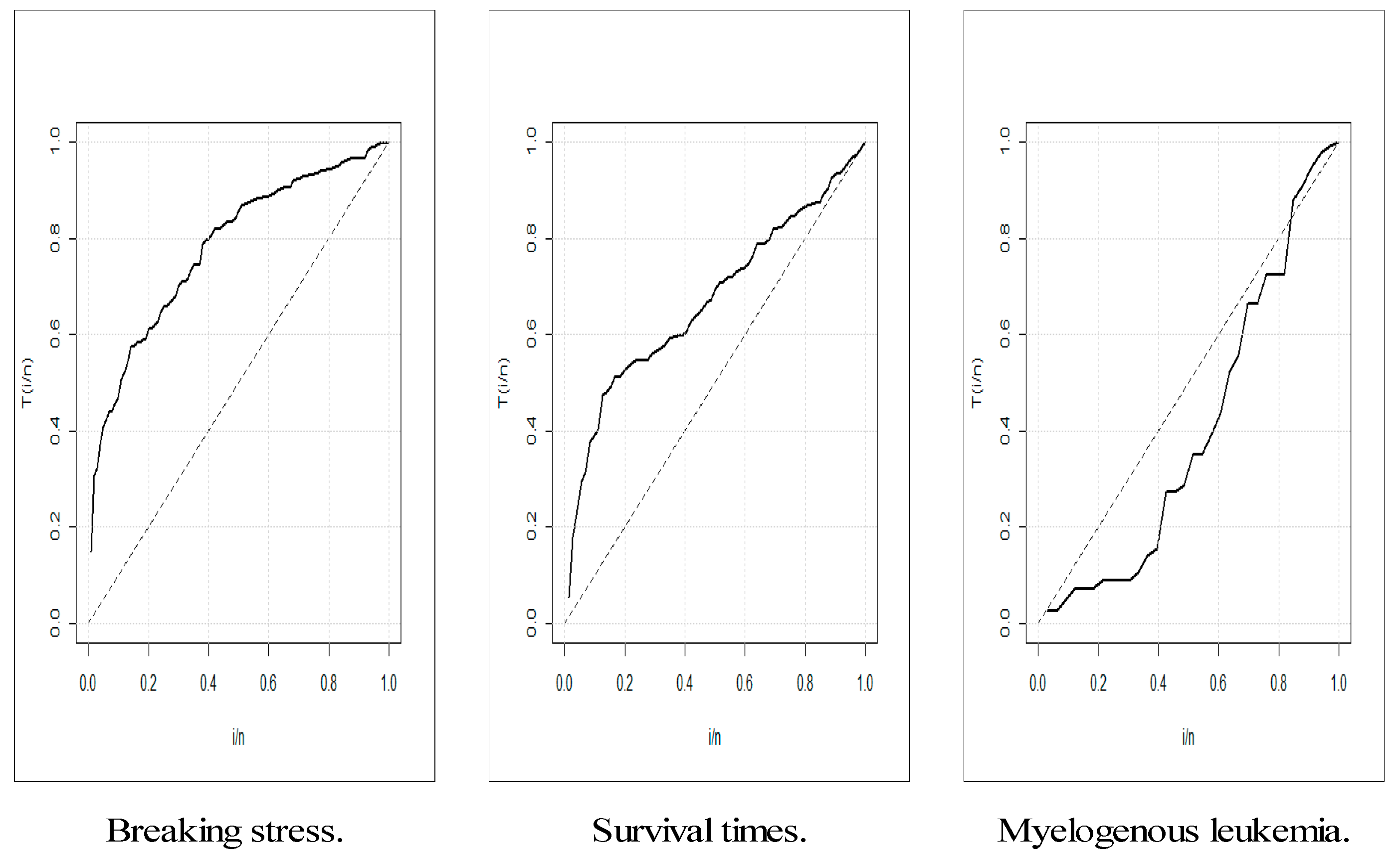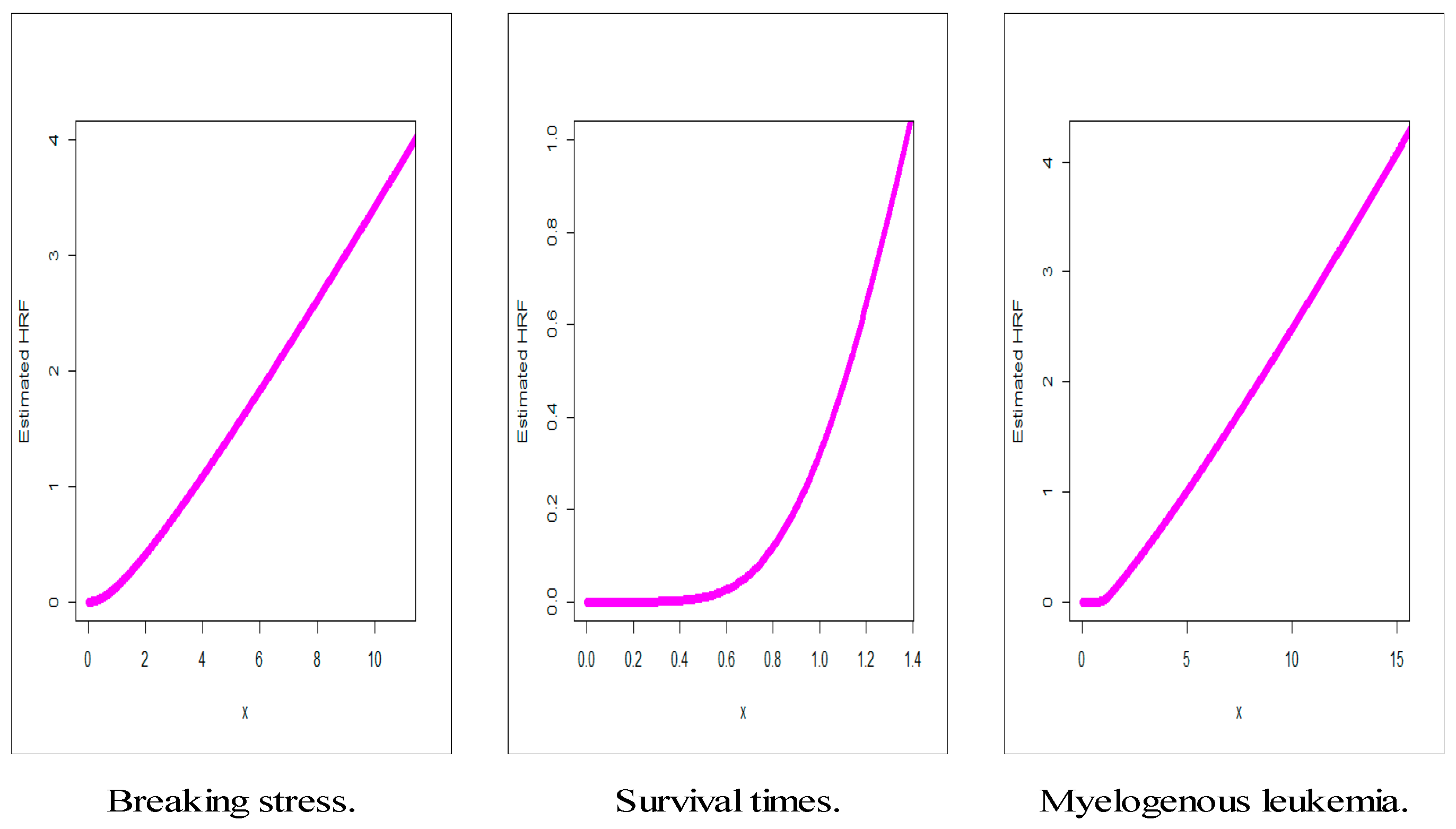1. Introduction
A new univariate version of the log-logistic (LL) model called the Rayleigh generalized log-logistic (RG-LL) distribution (see Equations (3) and (4) and their corresponding details) is introduced, studied, and checked in modeling censored and uncensored real datasets. Following the mathematical approach to the development of the RG-LL distribution, some new bivariate RG-LL type distributions using Farlie-Gumbel-Morgenstern (FGM) Copula ([
1,
2,
3,
4]), modified Farlie-Gumbel-Morgenstern Copula [
5], Clayton Copula, and Renyi’s entropy Copula [
6] are derived in this paper (see
Section 3). Two major reasons as to why copulas are of interest to statisticians ([
7]): “Firstly, as a way of studying scale-free measures of dependence; and secondly, as a starting point for constructing families of bivariate distributions.” Specifically, copulas are an important part of the study of dependence between two variables since they allow us to separate the effect of dependence from the effect of the marginal distributions. Further future articles could be allocated to study the new bivariate RG-LL type.
The new model is used for modeling three real datasets. The 1st data are an “engineering real-life data” and consist of 100 observations of “breaking stress of carbon fibers” given by [
8]. The 2nd data are a “reliability survival data” and called the “survival times”, in days, of 72 guinea pigs infected with virulent tubercle bacilli, this data were originally observed and reported by [
9]. The 3rd data are medical data and called leukemia data. This real dataset gives the survival times, in weeks, of 33 patients suffering from acute myelogenous leukemia. These applications are used to illustrate the importance, potentiality, and flexibility of the RG-LL model. The hazard rate function (HRF) of the 1st and 2nd real datasets is “monotonically increasing”. However, the HRF of the 3rd is “decreasing-constant-increasing”. These read datasets are analyzed by [
10,
11,
12,
13,
14,
15,
16,
17].
The RG-LL model has only three parameters. However, its competitive models have at least three parameters (or more) as illustrated in
Section 5 (
Table A3,
Table A4 and
Table A5). It is worth mentioning that, the lifetime model with a smaller number of parameters is a favorable one especially when if it gives a better (or same) fit. The RG-LL model has the lowest (best) value of the used criteria (see
Table A3,
Table A4 and
Table A5). Therefore, it is recommended to apply the RG-LL model in modeling instead of all the other competitive models. For the applied purposes, especially in the mathematical modeling, the RG-LL model could be useful in the following applied cases:
For these reasons, we are motivated to introduce and study the RG-LL distribution.
For simulation purposes, the algorithm of “Barzilai-Borwein” (BB) (see [
19]) is used via a simulation study for assessing the performance of the estimators with different sample sizes as the sample size tends to
(for more details, see [
20,
21,
22]). For validation purposes and using the BN-GOF test under the right censored data, we propose a modified chi-square GOF test for the RG-LL model. Based on the maximum likelihood estimators (MLEs) on initial data, the modified BN-GOF test recovers the loss in information while grouping data and follow chi-square distributions. All elements of the modified BN-GOF criteria tests are explicitly derived and given (for more details see [
20,
23,
24]).
Generally, the LL distribution is a continuous model for a non-negative random variables (RVs). It is used in survival analysis as a parametric model for events whose rate increases initially and decreases later such as mortality rate from cancer following diagnosis or treatment (for more details see [
25,
26,
27,
28,
29,
30,
31]). The LL model has also been used in hydrology in modeling stream flow and precipitation. In economics, the LL is employed as a simple distribution of the distribution of wealth or income. A RV
is said to have the one parameter LL distribution if its cumulative distribution functions (CDF) can be written as:
here
refers to the shape parameter. A scale and location parameter can be introduced in many ways to make (1) a three-parameter distribution. It is worth mentioning that the model in (1) is a member of the Pareto Type I distribution. The corresponding probability density function (PDF) of (1) is given by
The PDF in (2) is a special member from the well-known Burr type XII (BXII) model (see [
25,
26,
27,
28,
29,
30,
31]). Based on the family of [
15] and using (1), the CDF of the Rayleigh generalized LL (RG-LL) is defined by
the corresponding PDF to (3) is given as
For
the RG-LL model reduces to the two parameter RG-LL model. For
the RG-LL model reduces to the R-LL model (with three parameters). For
the RG-LL model reduces to the R-LL model (with two parameters). The HRF can be derived from
. Let
, the asymptotics of the CDF, PDF, and HRF as
are given by
and
The asymptotics of CDF, PDF and HRF as
are derived by
and
Figure 1 gives some plots of PDF and HRF for the RG-LL model. From
Figure 1 (left panel), we conclude that the proposed PDF of the RG-LL model can be “uniform”, “unimodal”, “symmetric” or “asymmetric left skewed” (or asymmetric right skewed (see
Table A1)). From
Figure 1 (right panel), the HRF can be “asymmetric monotonically increasing” (
) or “decreasing-constant” (
) or “
J shaped” (
) or “constant” (
).
The rest of the paper is organized as follows. In
Section 2, some mathematical properties of the new model are derived. In
Section 3, some new bivariate type versions using “Farlie-Gumbel-Morgenstern Copula”, “modified Farlie-Gumbel-Morgenstern Copula”, “Clayton Copula” and “Renyi’s entropy Copula” are obtained. In
Section 4, we provided three applications to real data to illustrate the flexibility of the new model. The modified BN-GOF test is presented and applied in
Section 5. Simulation experiments under censorship for assessing the new test are performed in
Section 6. Censored validation under real data is considered in
Section 7. Finally, some concluding remarks are addressed in
Section 8.
4. Uncensored Real Data Applications
The log-likelihood function (
) for
is given by
The above
can be maximized numerically via “SAS (PROC NLMIXED)” or “R (optim)” or “Ox program (via sub-routine MaxBFGS)”, among others. The components of the score vector
can be derived easily.
We provide three real applications to illustrate the importance, potentiality and flexibility of the RG-LL model. For these data, we compare the RG-LL distribution, with BXII, Topp-Leone-BXII (TLBXII), Zografos-Balakrishnan-BXII (ZBBXII), Marshall-Olkin-BXII (MOBXII), Five Parameters beta-BXII (FBBXII), Beta-BXII (BBXII), Beta exponentiated-BXII (BEBXII), Five Parameters Kumaraswamy-BXII (FKwBXII), and the KwBXII distributions given in [
11,
12,
13,
14,
15].
The 1st data: Called “breaking stress data”: {0.98, 5.56, 5.08, 0.39, 1.57, 3.19, 4.90, 2.93, 2.85, 2.77, 2.76, 1.73, 2.48, 3.68, 1.08, 3.22, 3.75, 3.22, 3.70, 2.74, 2.73, 2.50, 3.60, 3.11, 3.27, 2.87, 1.47, 3.11, 4.42, 2.40, 3.15, 2.67,3.31, 2.81, 2.56, 2.17, 4.91, 1.59, 1.18, 2.48, 2.03, 1.69, 2.43, 3.39, 3.56, 2.83, 3.68, 2.00, 3.51, 0.85, 1.61, 3.28, 2.95, 2.81, 3.15, 1.92, 1.84, 1.22, 2.17, 1.61, 2.12, 3.09, 2.97, 4.20, 2.35, 1.41, 1.59, 1.12, 1.69, 2.79, 1.89, 1.87, 3.39, 3.33, 2.55, 3.68, 3.19, 1.71, 1.25, 4.70, 2.88, 2.96, 2.55, 2.59, 2.97, 1.57, 2.17, 4.38, 2.03, 2.82, 2.53, 3.31, 2.38, 1.36, 0.81, 1.17, 1.84, 1.80, 2.05, 3.65}. This dataset consists of 100 observations of “breaking stress of carbon fibers” (in Gba).
The 2nd data: Called “survival times”, in days, of 72 guinea pigs infected with virulent tubercle bacilli: {0.1, 0.33, 0.44, 0.56, 0.59, 0.72, 0.74, 0.77, 0.92, 0.93, 0.96, 1, 1, 1.02, 1.05, 1.07, 07, 1.08, 1.08, 1.08, 1.09, 1.12, 1.13, 1.15, 1.16, 1.2, 1.21, 1.22, 1.22, 1.24, 1.3, 1.34, 1.36, 1.39, 1.44, 1.46, 1.53, 1.59, 1.6, 1.63, 1.63, 1.68, 1.71, 1.72, 1.76, 1.83, 1.95, 1.96, 1.97, 2.02, 2.13, 2.15, 2.16, 2.22, 2.3, 2.31, 2.4, 2.45, 2.51, 2.53, 2.54, 2.54, 2.78, 2.93, 3.27, 3.42, 3.47, 3.61, 4.02, 4.32, 4.58, 5.55}.
The 3rd data: {65, 156, 100, 134, 16, 108, 121, 4, 39, 143, 56, 26, 22, 1, 1, 5, 65, 56, 65, 17, 7, 16, 22, 3, 4, 2, 3, 8, 4, 3, 30, 4, 43} is called “leukemia data”. This real data set gives the survival times, in weeks, of 33 patients suffering from acute myelogenous leukemia. The total time test (TTT) plot (see [
40]) is an important graphical approach to verify whether the data can be applied to a specific distribution or not. The TTT plots of the three real datasets are presented in
Figure 2. This plot indicates that the empirical HRFs of the 1st and 2nd datasets are increasing. The empirical HRF is the bathtub for the 3rd dataset.
We consider the following goodness-of-fit statistics: The “Akaike information criterion” (
), “Bayesian information criterion” (
), “consistent Akaike information criterion” (
), and “Hannan-Quinn information criterion” (
).
Table A3,
Table A4 and
Table A5 (see the
Appendix A) give the MLEs, standard errors (SEs), and confidence interval (CIs) for all datasets. The same tables give the statistics
,
,
and
values for these datasets.
Based on the values in
Table A3, we conclude that the RG-LL model provides the best fit as compared to other competitive models in the three applications with the smallest values of
,
,
and
. Based on the values in
Table A4, it is noted that the RG-LL model provides the best fit as compared to other competitive models in the three applications with the smallest values of
,
,
and
. Based on the values in
Table A5, it is noted that the RG-LL model provides the best fit as compared to other competitive models in the three applications with the smallest values of
,
,
and
.
Figure 2,
Figure 3,
Figure 4 and
Figure 5 give the total time in test (TTT) plots, the estimated CDFs plots, the estimated PDFs plots, and the estimated HRFs plots, respectively. Based on
Figure 2, the HRF of the three data are “monotonically increasing”, “monotonically increasing”, and “decreasing-constant-increasing”, respectively.
Figure 3,
Figure 4 and
Figure 5 are provided for illustrating the superiority on the new model graphically.
Based on the values in
Table A3,
Table A4 and
Table A5 and
Figure 2,
Figure 3,
Figure 4 and
Figure 5, we conclude that the RG-LL model provides good (and also the best) fits as compared to other competitive models in the three applications with smallest values of
,
,
and
.











_Masoom_Ali.png)


